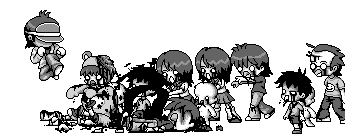
Category Archives: Uncategorized
I am really beginning to enjoy Basilisk, and not just because of the grotesquery and the action sequences. The emphasis in the series is more on the unrequited love between Gennosuke and Oboro ( and between the previous generations of the Iga and Kouga clans ) much like a Japanese version of Romeo and Juliet. The story happens in the rains, and the animators render the sequences in a dreamy, watercolour-based palette that’s stunningly beautiful. I need to go back and rewatch Shinobi ( the live-action film based on the same book) after I am done with this. A lot of characters have been shuffled around, if I remember correctly.
After a very long time, I read a Jeffrey Archer book, a collection of fairly-recent short stories, Cat O’Nine Tails. I used to like love Archer when about ten years ago, his novels were The Real Thing, his stories just the perfect level of heartwarming content and hair-raising endings. We ( a rather naive bunch of Guwahatians) used to rate short stories based on whether they were Archerian enough. O. Henry definitely was, as was Maugham. Saki was, at times. Ruskin Bond would try. I did say naive, didn’t I? Cat O’Nine Tails…sigh, well, it tries so hard to be like Jeffrey Archer that it made me groan at times. Nearly all the time. Despite telegraphing its intentions from the first page – it’s basically a compilation of con stories that the writer picked up during his stint as prisoner FF 8282, and it goes without saying that all the cons he writes about end in a stint in jail – despite telegraphing its intentions, Archer pretends he is writing stories that might lead somewhere else or end in a way that you didn’t expect was coming, but guess what? They don’t. Meh. There’s only so much white collar crime I can take in one sitting.
Once in a while – rather, most of the time – there is this inexplicable urge to sit still and consume a series from beginning till end, without falling for other consummables on the side. Be it a comicbook series, or a bunch of thematically-linked movies, a TV season or an anime series. Last week, it was one anime series, and one comicbook run. I finished thirteen episodes of Genshiken, the anime based on the manga by Kio Shimoku. The storyline follows that of the comic very closely – I have not been able to find the last few volumes of the manga, so I don’t really know how it ends in Shimoku’s version. Anime based on manga have this notorious tendency to veer away from the storyline of the work , mostly because the manga is slower to release, and the directors of the animated version have to come up with their own story once they overtake the written word.
Genshiken appealed to me primarily because of the glimpse it offers into the otaku culture. The stock of characters cover a diverse spectrum of otaku-levelness – from the strictly-anti-otaku Saki Kasukabe, who joins the Society For Study of Modern Visual Culture to keep tabs on hot gamer boyfriend Kousaka; shy, introverted Sasahara who wants to come to terms with his bizarre tastes in otakuness; the bespectacled, hardcore Madarame, obsessed with manga and doujinshi and games and Kujibiki Unbalance, the greatest anime-within-an-anime series ever. There are other members of the Genshiken, all of whom come with their own baggage and come to know each other against the backdrop of cosplay events, Comifest, doujinshi-hunting in Akihabara and general slacking around. While not really an engrossing series per se, Genshiken is the kind of anime ( and manga ) that you probably won’t enjoy unless you know a little about otaku culture – the series abounds with references to games, series and comics. A meta-anime anime, so to say.
And now I am watching Basilisk, another series that is a victim of the bought-first-couple-of-volumes-unable-to-find-rest syndrome. ( Damn you, Indian Booksellers! ) 24 episodes in this series, and I was done with 6 last night. I should take about three more days to finish this one. Lots of ninja action, the kind of ninja action that has grotesque creatures fighting each other with strange powers. So far, there is a ninja that controls his body hair to behave like tentacles, there’s a spider-like character whose primary power is to spit glue-like phlegm towards his enemies, there’s a short-lived character with no arms and legs that keeps his sword inside his gullet and fights with his tongue. Hrmm. Your cup of tea? Don’t think so.
Two Important Comic Art Events
One was the sale of Hergé’s original cover to Tintin in America in a recent auction for 650,000 EU ( technically, I should write the amount as 650.000 EU. Europeans apparently use decimal points where we use commas, and vice versa). Along with the auction premium price, the total came to 780 000 EU. At the prevailing dollar-EU exchange rate, this makes it the first piece of comic art to cross the one million dollar mark.
There was a lot of discussion among the American collectors about whether any US comic art would ever make it to that level. Quite a few of them were of the opinion that if the cover to Action Comics #1 ( the issue that marked the debut of Superman, way back in 1937), or Amazing Fantasy# 15 ( the first appearance of Spider-man ) ever came into the open market, they could easily bring a million dollars, both being cornerstones of American historical memorabilia and twentieth century popular culture. Until the Tintin cover sold, the most expensive comic art pieces were John Romita Sr Spider-man covers, one of which made 100,000$ a few years ago, and Peanuts Sunday pages which are currently at an alarming high because Charles Schultz’s estate is buying off almost every Schultz page that comes into the market. Of course, the comic art community is notorious for its secretive under-the-radar deals, so one can only hypothesise based on public information available through auction data.
My take on this, which I posted to a message board I frequent:
It’s not hard to imagine why (this Tintin cover) would command so high a price. Just as an example:
1) If John Romita Sr drew only 23 Spider-man comics in his lifetime, including covers and interiors,
2) if ALL of the art were locked up by the artist’s estate.
3) these were the only Spider-man comics to be published by Marvel
4) Romita Sr’s Spider-man was the kind of comicbook that parents would recommend to their kids and grandchildren for decades, thereby making those 23 comics a part of generations of readers and fans, spanning all ages.
With all these in mind, isn’t it natural that prices would skyrocket beyond belief if a single cover came out into the market?
There are only this number( 23) of Tintin covers, after all, and add to it the fact that they are Essential Comics, known and loved for 70+ years, and with translations in over fifty languages, one can hardly be bemused at the kind of hysteria an original Tintin cover would elicit from collectors.
You cannot extend this logic to other highly influential American creators – Kirby, Charles Schultz ( whose work I think is slowly approaching that level, because of the scarcity in the market introduced by the mass-buyout), and even Frank Frazetta because their volume of work is huge compared to Herge’s. It cannot even be extended to historic items like the cover of Superman #1, well, yes, that’s a historic cover, but there are other options for the discerning Superman collector – a landmark Curt Swan cover, or a Murphy Anderson splash, or even a Byrne cover. In case of Tintin, these 23 covers are ALL that there is, this might very well be the only chance a collector has, in his lifetime, to pick up an original Tintin cover, drawn by the only artist associated with the character. I know I would go all the way if I had the money. :-)
And the baseline is – the words ‘Tintin’ and ‘Herge’ elicit much more response in the non-comic-book reading masses ( outside the US, that is) than ‘Romita’ or ‘Schultz’ would – even though Spider-man and Peanuts are equally well-known and loved characters as the boy reporter.
Yesterday, there was the news that an anonymous collector had donated all 24 pages of Amazing Fantasy 15 to the Library of Congress, putting paid to all rumours of whether the art would ever surface and how much its value would be. The collector apparently refused to submit the pages for an official valuation( he doesn’t even get a tax benefit this way, and probably he does not even need it! ), and before the donation, even contacted the artist Steve Ditko to find out if he wanted them back. Ditko, a reclusive creator who refuses to be photographed, interviewed or bothered in any way whatsoever by fans, has a history of subjecting his own artwork to mutilation and it’s probably to everybody’s benefit that he did not claim any rights to the pages. It’s official – the first appearance of Spider-man now belongs to the American people. Half the collectors are now swooning over the fact that they can actually SEE the pages for themselves, the rest just crossed off the item from their wish-list.
This is particularly significant because nobody really knows where most of the art from that period is, and how much of it actually exists. Comic art was seen as disposable items once the print negatives were created, and were thrown in the trash, shredded or given away. It wasn’t until the seventies that artists like Neal Adams started the trend of the publisher having to return the art to the original artists. And once the comic art collectors’ market took off in earnest, there was a lot of art stolen from Marvel’s warehouses. To this day, the majority of Jack Kirby’s pages remain locked up in private collections, the owners fearing lawsuits and finger-pointing if they display the art to the world.
Sometimes it’s the waiting that kills me.
Machine Girl.
The Dark Knight.
Dororo volume 1.

The April/May Comiclink Featured original comic art auction.
